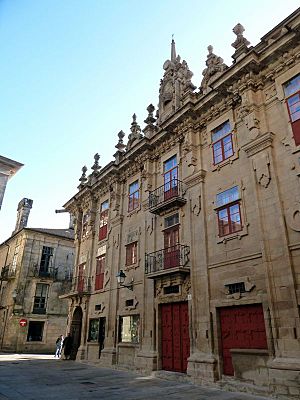Casa do Cabido facts for kids
The Casa do Cabido is a special old building in Santiago de Compostela, a city in Galicia, Spain. It stands right in front of the Praza de Praterías (Silversmiths' Square). This house was built to make the city look more beautiful and to fit in with the buildings around it. It was finished in 1758 and has a fancy style called Baroque.
A Special Building in Santiago
The square where the Casa do Cabido stands, Praza das Praterías, got its name from the silversmiths who worked there long ago. The Casa do Cabido was built across from the Cathedral's south side. It's quite shallow, only about three meters deep. Its main job was to make the square look complete and beautiful, like a stage set.
The building was designed by a famous architect named Clemente Fernández Sarela. He was known for his Baroque designs in Galicia. The Casa do Cabido was finished in 1758. At first, it was used by the Cathedral Council, which was a group linked to the main church. But in the mid-1800s, it became a private home.
Its Unique Design
The Casa do Cabido has a special front, or façade, that faces the Cathedral. This front was built to match the local building style of the early 1700s. It uses a design called "style of plates," which was common in the Baroque buildings of Santiago. This design helped the building blend perfectly with its historic surroundings.
In Books and Movies
The Casa do Cabido has even inspired artists! The famous writer Valle-Inclán used it as a setting for his story My Sister Antonia. The fountain nearby, called Fonte dos Cabalos, also inspired the poet Federico García Lorca for his poem Dance of the Moon in Santiago. In 2005, a movie called The Carpenter's Pencil was filmed there, showing off the building's unique charm.
See also
 In Spanish: Casa del Cabildo para niños
In Spanish: Casa del Cabildo para niños


